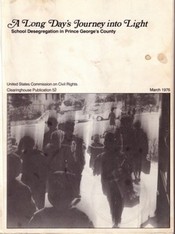Epilogue
The Long Days Journey

Clinton Grove Elementary (left), Theresa Douglas Banks image (center)
Rosaryville Elementary (right)
In March 1976, the United States Commission on Civil Rights published
a report on the desegregation of public schools in Prince George's County,
Maryland. A Long Day's Journey into Light: School Desegregation
in Prince George's County provides a detailed history of the
integration of public schools in the county from the early 1900s to
the mid-1970s. The following summary is gleaned from the information
in that report.
After more than 250 years, the agricultural economy of Prince George's County began to evolve into middle-class suburban community made up of single-family homes, garden apartments, government and retail industries. World War II, the expansion of employment opportunities with the federal government and the growth of private industry in the District Columbia brought with it an increasing demand for housing construction.
"One of the most rapidly growing suburban counties in the Nation in the 1960's, Prince George's County, Maryland, is larger in population than any other suburban jurisdiction of the Nation's Capital. With 660,000 people out of a metropolitan area total of nearly 3 million, the county was exceeded in population in the area only by the District of Columbia, which had a nearly stable population of 756,000." - Long Day's Journey
"At the time of the 1950 census, nearly 72 percent of the county's total population lived in urban areas, while 58 percent of the black population lived in rural areas. By 1970, however, the two groups were almost equally urbanized; 92 percent of the whites and 88 percent of the blacks." - Long Day's Journey
By 1970, Prince George's County had the largest black population of the suburban jurisdictions surrounding Washington, D.C. At that time, 55 percent (92,000 residents) of the county's population was of African-American descent. Still, black residents numbered on l4 percent of the population at that time.
Economically, the dynamics of black and white families changed dramatically from its historical legacy. Like white families, black families made up a substantial part of the "middle class and upwardly mobile" residents of the county.
Long Day's Journey provides a detailed look at the impact of housing patterns, residential segregation caused by discrimination in real estate sales, racially restrictive covenants forbid the sale of land or housing to African-Americans, and the real estate developers who capitalized on the fear of white residents when black people moved into their neighborhoods.
The end result was the continued segregation of the public school system and the re-segregation of residential neighborhoods.
The 1960s and 70s has been forever connected to profound social and political change in the history of the United States. The Civil Rights, Black Power, Peace, Women's and Environmental movements pushed forward during two decades of protests, social and political action. It was within this national environment, that black parents in Prince George's County, as did citizens across the Nation, push for the desegregation of the nation's public school system.
For decades, Black children were bussed to schools outside of their neighborhoods in order to maintain a segregated public school system. During the 1960s and 70s, for the first time in the history of the public school system in Prince George's county, the Federal Government would order public school systems to consider using transportation (or busing) not to maintain segregation, but to achieve the complete integration of the public school system.
Throughout the period of the 1960s, black parents and community groups in support of desegregation of the public schools continually appeared before the Board of Education to protest policies or actions that would continue to perpetuate a segregated school system. Their fight would involve the federal government's Office of Civil Rights.
But it would not be until the year 1972, nearly 100 years after Reconstruction and 18 years after Brown vs Board, that Prince George's County would finally be forced to fully come up with a plan to desegregate it's public school system.
On March 29, 1972, the parents of eight children attending the county's public schools, filed suit in federal court "seeking declaratory and injunctive relief to remedy racial discrimination resulting in segregation of children and faculty and racial discrimination in the district's provision of public education." The court case came to be known as Vaughns vs Prince George's County Board of Education. The American Civil Liberties Union and the National Association represented the plaintiffs for the Advancement of Colored People.
